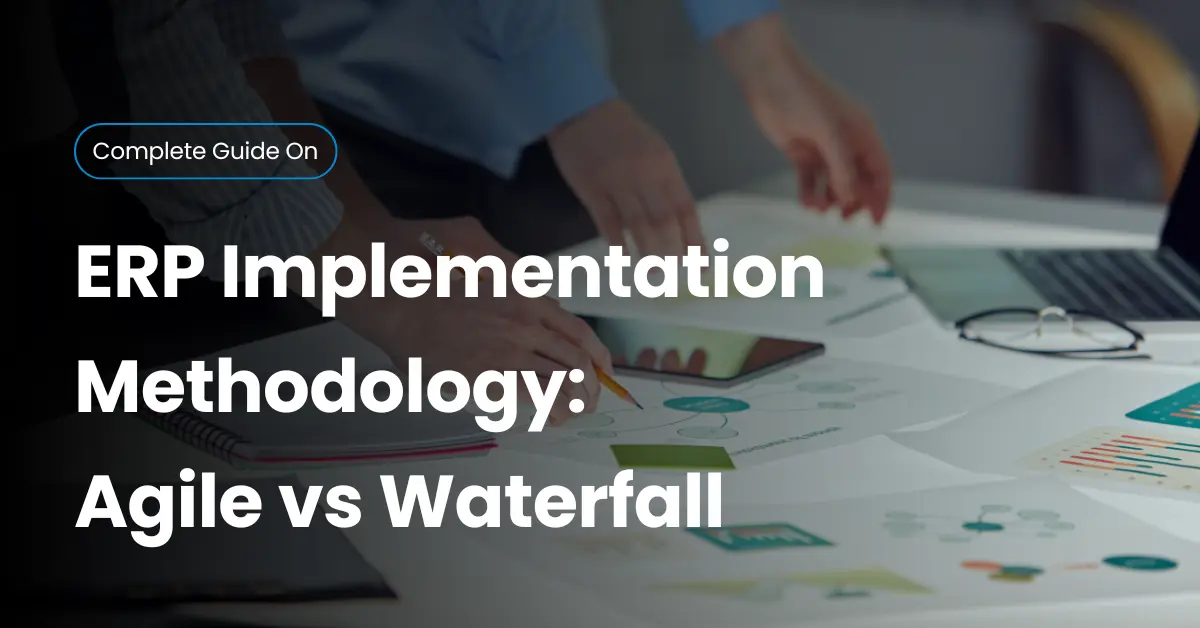Choosing the right ERP implementation methodology can make or break your project. Many businesses invest heavily in ERP systems like ERPNext or Odoo, expecting streamlined operations — only to face delays, cost overruns, or frustrated teams. The problem isn’t always the software; it’s often how the project is managed.
Your ERP system connects finance, HR, inventory, sales, and operations into one cohesive platform. But without a clear implementation approach, even the most advanced ERP solution can fall short. That’s why understanding the differences between Agile and Waterfall methodologies is crucial — one emphasizes flexibility, the other predictability. Knowing which fits your business can mean the difference between success and rework.
What Is an ERP Implementation Methodology (and Why It Matters)
An ERP implementation methodology is the structured framework that guides how your ERP system is planned, configured, tested, and deployed. It’s your roadmap — ensuring that everyone from executives to developers works toward the same milestones throughout the implementation lifecycle.
A strong methodology helps your team avoid confusion, manage risks, and deliver on expectations. It defines not just the project plan, but also how your ERP partner collaborates with internal stakeholders, gathers requirements, and handles testing and go-live.
Definition and Core Purpose
Think of ERP methodology as a blueprint. It dictates how the project moves from discovery to deployment — aligning business requirements, technical work, and team collaboration. Without it, even a capable system like Odoo or ERPNext can end up underused or misaligned with actual business needs.
How the Right Methodology Impacts ERP Success
Choosing the right ERP project management approach leads to:
- Clearer cross-department alignment
- Reduced risks and smoother handoffs between teams
- Accurate forecasting for time and cost
- Stronger user adoption after go-live
Here’s why it matters: methodology defines how efficiently your ERP adapts to your business — not the other way around.
The Waterfall Methodology: Sequential and Predictable
The Waterfall methodology follows a linear and sequential structure. Each phase must be completed before moving to the next — from requirements gathering to go-live. It’s often preferred in industries where processes are well-defined and compliance-driven, such as manufacturing or finance.
Waterfall offers stability. Once your project requirements are set, the team works through clear phases — planning, design, development, testing, and deployment. This makes budgeting and resource allocation easier, but it also leaves little room for mid-project changes.
Phases of the Waterfall ERP Implementation
| Phase | Description |
| Requirements Gathering | Collect detailed business processes, data needs, and functional goals. |
| Design | Create a system blueprint aligned with fixed scope and project plan. |
| Development | Configure modules, build customizations, and migrate initial data. |
| Testing | Validate features, integrations, and reports before rollout. |
| Deployment & Go-Live | Launch system to all users in a single rollout. |
| Maintenance | Post-implementation support and updates. |
When Waterfall Works Best
Waterfall fits when:
- Business processes are standardized and not expected to change.
- Stakeholders prefer a fixed-scope project.
- You need strict documentation and audit control.
That said, Waterfall can struggle in dynamic environments where priorities shift or new insights surface mid-project. Changes late in the cycle often lead to scope creep and rework — two common causes of ERP implementation delays.
The Agile Methodology: Iterative and Collaborative
Where Waterfall locks scope early, Agile methodology emphasizes adaptability. It divides your ERP project into short, focused sprints — each delivering a working piece of functionality. Teams review, test, and adjust quickly based on user feedback.
Agile thrives in fast-moving industries where requirements evolve. For example, a retailer implementing Odoo can prioritize inventory and POS modules first, then refine CRM or HRM as new insights emerge. Each sprint moves the system closer to full adoption — and keeps stakeholders engaged throughout.
Key Traits of Agile ERP Implementation
- Iterative approach: Development happens in small, measurable increments.
- Continuous feedback: Stakeholders and end-users test early and often.
- Cross-functional teamwork: Business and technical teams collaborate daily.
- Flexible scope: Adjustments are welcomed, not penalized.
When Agile Works Best
Agile suits organizations that value collaboration and adaptability — such as growing startups or service providers. It’s especially effective when implementing open-source systems like ERPNext, where customization plays a key role.
The trade-off? Without disciplined governance, Agile projects can drift or expand beyond scope. That’s why clear priorities and strong change management are critical to maintain direction.
Agile vs Waterfall: A Detailed ERP Implementation Comparison
The question most business leaders ask is simple: Which delivers better results — Agile or Waterfall? The answer depends on your organization’s structure, pace of change, and risk appetite. Below is a practical comparison of how each methodology performs across key project management criteria.
Agile vs Waterfall: Comparison Table
| Criteria | Agile Methodology | Waterfall Methodology |
| Flexibility | Highly adaptable to evolving requirements | Low — changes disrupt project flow |
| Planning Style | Iterative and incremental | Fixed upfront |
| Speed to Deploy | Faster through short sprints | Slower due to sequential phases |
| Risk Management | Ongoing — issues addressed early | Risks found later during testing |
| User Feedback | Continuous and hands-on | Limited until late stages |
| Best For | Dynamic or evolving businesses | Structured, compliance-driven organizations |
This side-by-side view shows that Agile favors adaptability, while Waterfall favors predictability. The challenge isn’t picking the “right” one — it’s aligning the approach with your project’s DNA.
Strengths and Limitations of Each Approach
Agile Pros:
- Continuous improvement through regular feedback
- Faster ROI via incremental releases
- Engaged stakeholders who shape outcomes
Agile Cons:
- Scope creep if priorities aren’t managed
- Requires high team discipline and visibility
Waterfall Pros:
- Clear documentation and structure
- Easier to forecast costs and timelines
Waterfall Cons:
- Late feedback can expose major gaps
- Limited flexibility once development starts
In practice: Many modern ERPNext implementations use a hybrid form — structured upfront, flexible in execution.
When Each Methodology Works Best
- Manufacturing ERP: Waterfall aligns with regulated, standardized workflows.
- Tech Startups: Agile supports rapid iterations and innovation.
- Retail and Distribution: Hybrid models work best, balancing planning with agility.
The takeaway? Don’t pick based on popularity. Choose based on your business requirements, team maturity, and process volatility.
The Hybrid ERP Implementation Methodology: Bridging Agile and Waterfall
In recent years, many ERP experts have adopted the hybrid approach — combining Agile’s flexibility with Waterfall’s structure. It’s an effective compromise for large organizations that need both control and adaptability.
What Is a Hybrid ERP Model?
A hybrid ERP implementation methodology starts with a Waterfall-style planning phase — gathering requirements, defining scope, and setting milestones. Once development begins, the process shifts to Agile sprints, enabling teams to refine modules through short feedback cycles.
Key Benefits of the Hybrid Approach
- Balanced structure and flexibility
- Early testing without losing long-term visibility
- Better stakeholder involvement
- Reduced risk of rework or misalignment
Example Hybrid ERP Rollout Framework
| Phase | Approach Used | Description |
| Planning | Waterfall | Define scope, objectives, and architecture |
| Development | Agile | Build modules in short, iterative sprints |
| Testing | Combined | Validate modules early and progressively |
| Deployment | Waterfall | Controlled, phased go-live |
| Post-Go-Live Feedback | Agile | Continuous improvement and updates |
This blended methodology suits organizations that want predictability without sacrificing responsiveness — a common need in multi-department ERP rollouts.
How to Choose the Right ERP Implementation Methodology
Selecting the right methodology isn’t just a technical call — it’s a strategic decision. It should align with your company’s culture, processes, and long-term growth plans.
Key Factors to Consider
- Project complexity: How many modules and integrations are involved?
- Business environment: Is your industry stable or fast-evolving?
- Budget flexibility: Can you adapt funding as the project evolves?
- Team maturity: Do your users and IT team understand iterative collaboration?
- Change readiness: Is your organization open to adapting workflows mid-project?
Step-by-Step Methodology Selection Checklist
- Define your business requirements clearly.
- Assess how frequently those requirements may evolve.
- Evaluate your implementation partner’s experience with both methodologies.
- Identify how much stakeholder involvement you can sustain.
- Choose the model that offers control without stifling progress.
In most cases, ERPNext and Odoo partners tailor a hybrid model to fit client maturity — offering Waterfall’s structure with Agile’s feedback loop.
Common ERP Implementation Challenges (and How to Prevent Them)
Even with a solid plan, ERP projects face challenges — from missed deadlines to user resistance. Understanding these risks early helps prevent implementation failure.
Typical Pitfalls in Waterfall and Agile ERP Projects
- Waterfall: Limited flexibility, late-stage defect discovery, slow feedback cycles.
- Agile: Poor documentation, scope creep, unclear accountability.
Both can derail progress if not managed carefully.
How to Mitigate Risks Early
- Set realistic timelines and maintain visible project governance.
- Schedule regular checkpoints with your ERP implementation partner.
- Prioritize training and change management before go-live.
- Use phased rollouts to minimize disruption.
- Encourage user feedback during every stage — not just testing.
At Infintrix Technologies, we’ve seen hybrid governance models cut project risk by up to 30% — simply by combining clear planning with responsive execution.
Best Practices for a Successful ERP Implementation
Regardless of methodology, every successful ERP implementation project shares a few universal habits. These best practices of ERP implementation keep teams aligned and systems effective long after deployment.
Align Business Goals with ERP Capabilities
Your ERP system — whether ERPNext or Odoo — should solve real business problems, not just automate existing inefficiencies. Define measurable objectives (e.g., faster reporting, reduced manual entry) before configuration begins.
Prioritize Change Management and User Training
Technology adoption depends on people. Plan for ongoing ERP training and communication. When users understand why processes change, adoption rates and satisfaction increase dramatically.
Measure and Optimize Post-Go-Live
Implementation doesn’t end at go-live. Collect usage metrics, gather feedback, and schedule quarterly optimization reviews. Continuous improvement ensures your ERP keeps evolving with your business.
Conclusion: Choose the ERP Implementation Methodology That Fits — Not What’s Popular
Every ERP project is unique. The best methodology depends on your business culture, complexity, and tolerance for change — not on trends. Waterfall offers control; Agile offers adaptability; Hybrid offers the balance most organizations need.
Whether you’re implementing ERPNext, Odoo, or another ERP platform, your goal remains the same: a system that enhances visibility, efficiency, and decision-making across your enterprise.
At Infintrix Technologies, we help businesses choose and execute the methodology that fits — ensuring smooth implementation, engaged teams, and long-term ROI.
FAQs: ERP Implementation Methodology Explained
What are the main stages of ERP implementation?
Typical stages include discovery, design, development, testing, deployment, and support. Each methodology structures these phases differently.
Is Agile effective for large-scale ERP projects?
Yes — though large projects often use a hybrid approach to combine Agile’s flexibility with Waterfall’s governance.
Can Agile and Waterfall be combined in ERP implementation?
Absolutely. Many modern ERPNext and Odoo rollouts blend both methods, using Waterfall for planning and Agile for iterative execution.
How long does ERP implementation take using each methodology?
Waterfall: 12–24 months.
Agile: 6–12 months.
Hybrid: varies by project size, customization, and team readiness.
Which ERP implementation methodology is most cost-effective?
Agile minimizes rework costs through early feedback. Waterfall offers tighter cost control in well-defined projects. Hybrid models balance both effectively.

